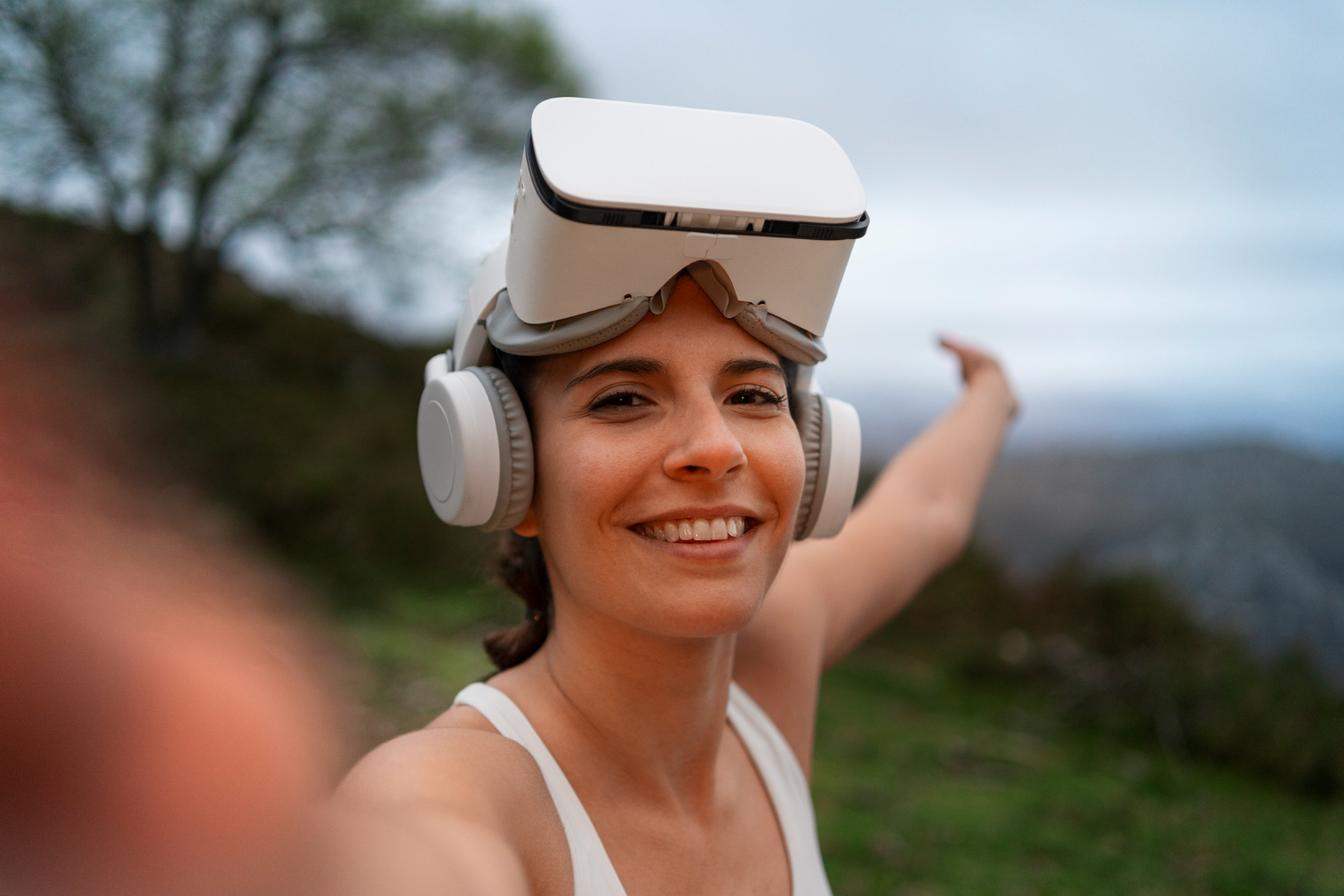Introduction
3D and augmented reality (AR) are transforming digital interactions. AR technologies blend digital content with the physical world, offering immersive experiences. Artificial intelligence enhances these systems, making them more responsive. Users can access these features on a mobile device, bringing interactive content to their fingertips.
How 3D and Augmented Reality Work
AR apps overlay computer-generated elements onto a real-world environment. This enhances digital engagement by merging virtual objects with real-life surroundings. People can interact with 3D models, change backgrounds, and add visual effects in real time.
Many platforms integrate AR-powered features to improve content creation. A social networking site may allow users to add interactive filters. However, a social media app enables users to place virtual objects in their space. Businesses use these tools for marketing, product displays, and interactive advertising.
Read more: 3D Visualisation Just Became Smarter with AI
The Role of Mobile Devices in AR Adoption
Smartphones and tablets process AR elements, making the technology widely accessible. Cameras and sensors detect surfaces, allowing users to interact with digital objects. The growing power of mobile devices improves the quality of augmented reality experiences.
These innovations extend beyond entertainment. Retail brands use AR apps to let customers try on clothes virtually. Home design companies enable users to see how furniture looks in their living space. These applications improve convenience and decision-making.
3D Models in Digital Content
3D models add depth to online content. They allow users to view objects from different angles, enhancing interaction. These models appear in product showcases, virtual tours, and educational applications.
Businesses use 3D visuals to make digital content more engaging. Customers can examine products as if they were physically present. This improves customer confidence and increases sales.
AR Technologies in Video Games
Video games have adopted AR technologies to create more immersive gameplay. Players interact with virtual objects in a real-world environment. Some mobile games use an AR system to track movements and place game elements in physical spaces.
Gaming platforms integrate artificial intelligence with AR to provide adaptive experiences. Environments respond to player actions, creating personalised challenges. This makes gaming more dynamic and engaging.
Read more: Level Up Your Gaming Experience with AI and AR/VR
The Growth of Virtual Reality (VR)
While augmented reality enhances the real world, virtual reality (VR) creates entirely digital experiences. Some platforms support VR spaces where users can interact using avatars. These platforms allow friends to meet, chat, and participate in activities within a computer-generated setting.
VR requires dedicated headsets, limiting accessibility. In contrast, AR-powered content is widely available through mobile devices. This makes augmented reality the preferred choice for many users.
AR in Social Networking
Social networking sites integrate AR-powered tools to enhance digital communication. Filters, stickers, and 3D effects encourage creativity. Businesses use these features to build engaging marketing campaigns.
Some platforms allow developers to create open-source AR experiences. This enables users to customise digital interactions, leading to innovative applications.
Advertising and Shopping with AR
Brands use AR-powered experiences to engage customers. Businesses create interactive ads where shoppers can try on products virtually. Clothing brands offer AR apps that show how outfits fit before purchasing.
Furniture retailers use AR to place 3D models of products in customers’ homes. This improves the shopping experience, making it easier to make informed decisions.
AR in Education and Learning
Augmented reality AR is transforming education. Schools and universities use AR-powered applications to enhance learning. AR apps provide interactive models, allowing students to engage with subjects visually. Instead of reading about complex structures, learners can interact with 3D models in real time.
Science lessons become more engaging when students can see detailed models of human anatomy, planets, or chemical reactions. History classes benefit from AR reconstructions of ancient landmarks, giving students a better understanding of historical events. AR-powered tools help bridge the gap between theory and practical application, improving knowledge retention.
Read more: VR for Education: Transforming Learning Experiences
AR and 3D in Healthcare
The medical field benefits greatly from AR technologies. Surgeons use AR-powered systems to overlay computer-generated models on a real-world environment. This helps them perform precise procedures. Medical students train using 3D models of organs and body systems, gaining hands-on experience without live patients.
AR-powered apps assist in physical therapy by guiding patients through exercises. Some healthcare providers use AR to explain medical conditions, improving communication between doctors and patients. These technologies enhance accuracy, training, and patient care.
AR in Architecture and Interior Design
Architects and designers use augmented reality AR to visualise projects before construction begins. AR-powered tools create interactive blueprints, helping clients see how buildings and rooms will look. 3D models enable users to explore structures from different angles, making planning more effective.
Interior designers use AR apps to place virtual furniture in a physical world setting. This helps customers decide on styles and layouts before making purchases. With AR-powered features, decision-making in home improvement becomes faster and more reliable.
Read more: AI in Architecture: Structure Beyond Limits
AR for Tourism and Travel
Tourism has embraced augmented reality AR to enhance visitor experiences. Travel apps provide AR-powered guides that overlay historical information on landmarks. Tourists can use smartphones and tablets to scan locations and receive instant details.
Museums and cultural sites integrate AR technologies to bring exhibits to life. AR-powered interactions allow visitors to see reconstructed historical artefacts, making exhibits more immersive. Virtual guides lead travellers through destinations, providing enriched experiences beyond traditional maps and brochures.
Read more: Exploring Virtual Museums and the Digital Past with AI and AR VR
AR in Automotive Industry
The automotive sector integrates augmented reality AR to improve both design and user experience. Manufacturers use AR-powered tools to develop vehicle prototypes with interactive 3D models. Engineers refine car designs before production, reducing costs and errors.
Drivers benefit from AR-powered heads-up displays that provide real-time navigation. These systems overlay directions, speed limits, and alerts on the windshield, improving safety.
Read more: Augmented Reality in Cars: AR in the Automotive Industry
AR in Retail and E-Commerce
Retailers use AR-powered solutions to improve customer experiences. AR apps allow shoppers to try on clothes, accessories, or makeup virtually. 3D models let customers see how furniture or appliances fit into their spaces.
E-commerce platforms integrate AR-powered previews to reduce return rates. Customers gain confidence in their purchases when they can see products in a real-world environment before buying. Brands that adopt AR technologies attract more engagement and boost sales.
Read more: How AR and AI Redefine Virtual Try-On in E-Commerce
AR in Entertainment and Live Events
Entertainment industries integrate augmented reality AR to create immersive experiences. Concerts and live performances use AR-powered visuals to enhance stage designs. Virtual elements appear alongside performers, creating stunning effects.
Sports events also benefit from AR technologies. Broadcasters overlay real-time statistics on screens, allowing viewers to see player performance instantly. Stadiums integrate AR-powered apps that provide fans with live updates, player insights, and interactive features.
AR in Public Services and Smart Cities
Governments and city planners adopt augmented reality AR to improve urban planning. AR-powered mapping systems provide real-time navigation, improving traffic flow. Public services use AR apps to guide citizens through administrative processes with digital overlays.
Emergency responders use AR-powered tools to assess disaster areas. AR helps firefighters, police, and medical teams identify hazards in real-time, improving response efficiency. These technologies continue to improve safety and accessibility in modern cities.
Read more: The Future of Cities Lies in AI and Smart Urban Design
The Role of Artificial Intelligence in AR
Artificial intelligence enhances AR-powered experiences. AI improves AR apps by analysing user interactions and adjusting responses. AI-powered AR systems create more accurate and personalised experiences.
AI-powered tools improve facial recognition for AR filters. They also enhance object detection, making AR interactions smoother. In gaming and entertainment, AI-driven AR technologies create realistic environments that adapt to player movements.
The Future of Augmented Reality and 3D Content
As technology improves, augmented reality will become even more interactive. Artificial intelligence will refine how digital objects respond to the real world. Open-source development will expand AR applications, giving users more control.
Faster mobile devices will improve processing speeds, making augmented reality and 3D content more realistic. More industries will integrate these features, enhancing customer engagement and digital experiences.
How TechnoLynx Can Help
TechnoLynx develops cutting-edge AR-powered solutions. We create interactive filters, 3D models, and AI-driven AR tools. Whether you need an AR system for your business or an engaging digital experience, we provide expert solutions. Contact us today to bring your ideas to life.
Continue reading: How Artificial Intelligence Transforms Social Media Today
Image credits: Freepik













